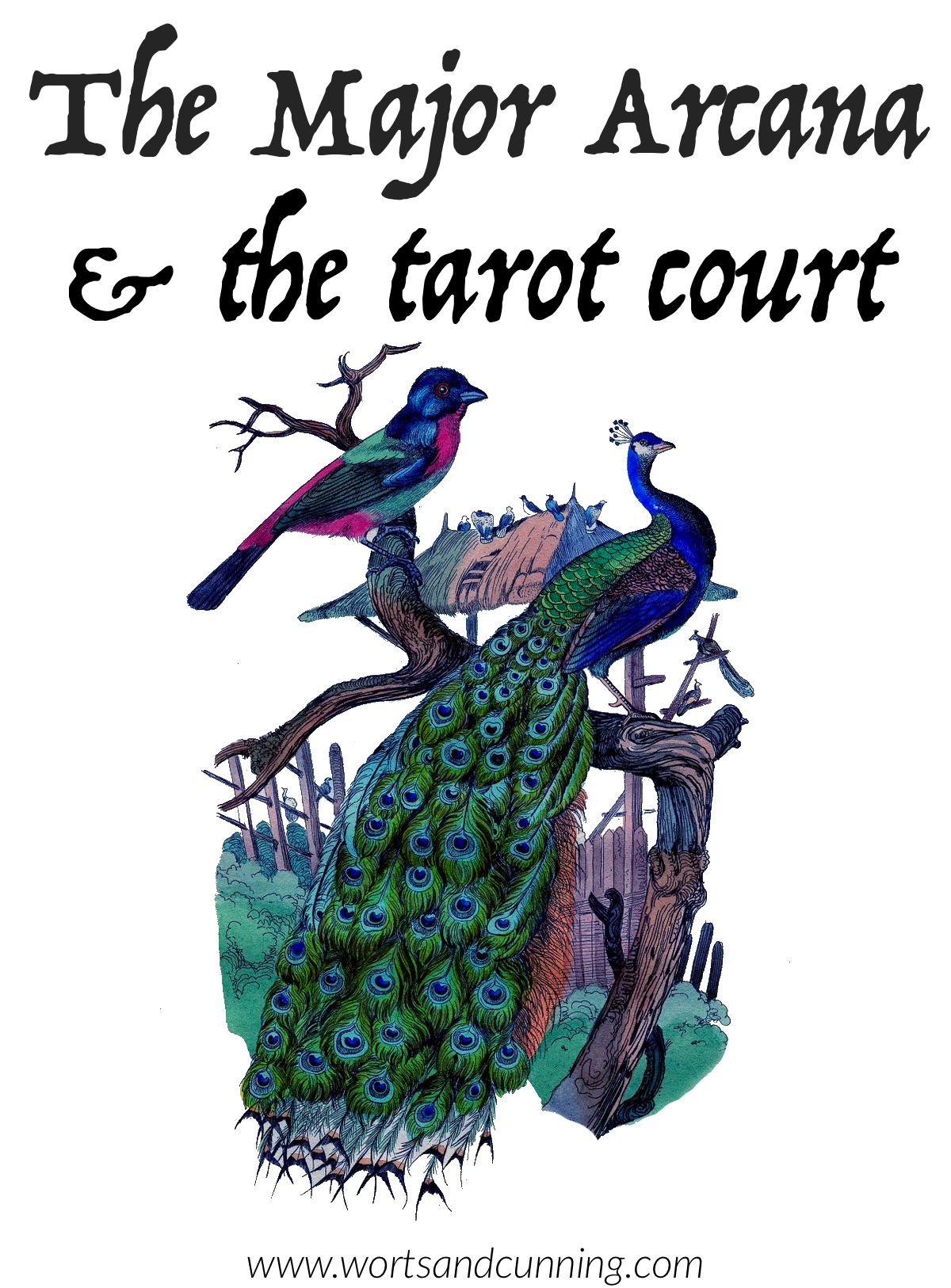Finding The Pattern: The Major Arcana & the Tarot Court
The tarot is a fascinating tool of communication and clarity, where we build trust in our own stories through the mythic archetypes presented to and invented by us in the cards.
When I held my first tarot deck and saw all the patterns spread out before me in the images of the cards, I was completely enchanted and continue to be enchanted by the cards all these decades later. While there is plenty of esoteric mystery to explore with the cards, the tarot, at its roots, is simply pointing out patterns of common experiences. From the pain of a broken heart, the pride of a skill well-developed, the boredom we all experience from time to time, the way grief changes us, and how we feel open and brave we can feel when we are able to be who we really are in the world - all these stories and so many more are told in the tarot. Storytelling is one of the ways we develop empathy and curiosity about ourselves and others, and the tarot is a storytelling tool.
One of the structures of story found in the tarot is the delineation between the Major Arcana, which are cards signifying major life events and patterns, and the Minor Arcana or cards that represent day-to-day experiences. Within the Minor Arcana is the tarot Court which are a set of sixteen characters that have an interesting relationship to the Major Arcana, helping us to find big patterns in small moments.
Knowing that the tarot court cards are ones that readers struggling with again and again (myself included!), from their hierarchical structure to sparse traditional meanings and more, I wanted to share the ways that I have come to understand the tarot court in a way that brings meaning to my own, and hopefully your, healing practice. I started earlier this year by exploring the often difficult to decipher tarot Court through the lens of healing ritual (check out part one and part two).
Now, I want to explore the tarot court in a way that's a bit more experimental and intuitive.
One of the fascinating aspects of the tarot Court cards are the way that they act like a more subtle expression of the energy and archetypes of the Major Arcana cards. Major Arcana cards often represent big energy and patterns in our life that are showing up over an extended period of time, whereas the Minor Arcana, including the Court, represent smaller energetic patterns and day-to-day insights. Yet, the deep patterns of the Major Arcana are reflected in the everyday experiences of the Minor Arcana, especially in the Court.
When I see the Page of Swords show up in a reading, for example, I am reminded of the energy of the Magician. While the Page of Swords has achieved some level of skill and self-control, they are are still developing their confidence and knowledge. Their body, however, has already begun to mimic that of he Magician, directing them to the wisdom of “As Above, So Below.” For me, the Page of Swords hints at the energy of the Magician, but in a more subdued and developing way. We are not meant to be gazing at the mysteries with intensity everyday (the Magician), but we are still living in a world of those mysteries (Page of Swords). In other words, the mysteries as profound are represented by the Magician while the mysteries as profane are represented by the Page of Swords.
While not every day is a profoundly meaningful sort of Major Arcana day, the energy of the Major Arcana and profundity is always at play. Through the Court cards we are a way to spot some of those deep currents of mystery represented by the Major Arcana. One of the ways these correspondences work in readings is by helping us understand our relationships with other folks in the grander scheme of our personal Major Arcana journey.
Let’s say that you pull the Page of Pentacles for a card representing a new significant other in your life. I connect the gentle energy of the Page of Pentacles with the Strength card, which would tell me that this new significant other in your life may illuminate the dynamic of Strength in your life, whether by testing it, affirming it or in some other way connect with how you embody and connect to Strength in your life. The Court cards are not meant to identify a deep valley or high peak of a pattern of energy - that’s the work of the Major Arcana - but help us to notice where that pattern is occurring in a more diffused way in our everyday life.
If you're intrigued by this idea of the Major Arcana’s connection with the Court, I’ve gone ahead and listed my very loose correspondences between the Major Arcana and the Minor Arcana. For my personal correspondences, there are a few Major Arcana cards that don’t have direct links to the Court: the Fool, the Lovers, the Wheel of Fortune, the Star, the Moon, and the Sun. The lack of correspondence for these Major Arcana cards are for the following reasons:
The Fool always represents who is being read for so doesn’t need a corresponding Court card
With The Lovers, no Court card seemed to represent that particular energy to me but instead any Court card could represent oneself or others in a Lovers relationship (which is a traditional meaning for the Court card, the current, past or prospective romantic partner).
The Wheel of Fortune is an abstracted, impersonal energy and does not easily correspond to any of the inherently personal Court cards.
The celestial cards (The Star, The Moon, and The Sun) are similar to the current of the Fool, being deeply personal to those being read for.
I created my Major Arcana and Court card correspondences when working with my Smith Waite Tarot and the imagery of this particular deck of cards definitely contributed to my correspondence choices. Keep that in mind if you’re interested in creating your own correspondences for your favorite deck (which I hope you do!). There are more traditional ways of connecting one card to another, mostly through astrological correspondences, but that was not my focus for my own list. I hope you feel inspired by tradition but not burdened or beholden to it whenever you read the cards, create correspondences, and use tarot as a tool of healing.
The Major Arcana & Court Card Correspondences
0. The Fool: See Note Above
I. The Magician: Page of Swords
II. The High Priestess: Page of Cups
III. The Empress: Queen of Wands
IV. The Emperor: King of Wands
V. The Hierophant: King of Cups
VI. The Lovers: See Note Above
VII. The Chariot: Knight of Pentacles
VIII. Strength: Page of Pentacles
IX. The Hermit: Queen of Pentacles
X. Wheel of Fortune: See Note Above
XI. Justice: King of Swords
XII. The Hanged Man: Knight of Cups
XIII. Death: Page of Wands
XIV. Temperance: Queen of Cups
XV. The Devil: King of Pentacles
XVI. The Tower: Knight of Wands
XVII. The Star: See Note Above
XVIII. The Moon: See Note Above
XIX. The Sun: See Note Above
XX. Judgement: Knight of Swords
XXI. The World: Queen of Swords
Finding the Pattern Tarot Spread
If you are trying to better understand how the pattern of a Major Arcana card is playing out in your personal relationships and development of your own identity in these relationships, the following spread is meant to help.
Begin by choosing the Major Arcana card whose energy you want to explore, setting that at the top of your spread. Next, separate out the Court cards from your deck - you'll be pulling only from the Court cards for this spread.
Card 1. How I am Manifesting the Pattern
This card represents how you currently understand and are manifesting the energy of the pattern of the Major Arcana card you are exploring. For our example, let's say you are exploring the energetic patterns of the Hierophant in your life and you pull the King of Cups to represent you. The King of Cups shows that you are deeply engaged in the work of examining the hierarchical structures, restrictions, and allegiance to authority in your life, that this is a front and center focus for you. If you are seeking more clarity, you can pull two more cards from the Minor Arcana to represent how you can ease the strain of this pattern in your life (i.e. the Hierophant energy can be very serious, here are some ways to lighten up) as well as support your explorations (i.e. talk about what you're exploring with friends instead of trying to untangle it all on your own).
Card 2. The Person Helping My Understanding of the Pattern
This card, as the position title suggests, helps you identify a person in your life who is beneficially assisting your ability to explore and understand the energy of the Major Arcana card you are working with. Everything from personal and familial relationships, social and work relationships, as well as para-social relationships can show up here. For our example let's say that you pull the Queen of Pentacles who represents the energy of your high school English teacher who encouraged all of their students to read banned books, helping you to understand how the energy of the Hierophant often seeks to restrict the flow of information.
Card 3. The Person Hindering My Understanding of the Pattern
This card helps you to identify a person in your life who is challenging your ability to understand the energy of the Major Arcana card you're exploring. For our example, you might pull the Knight of Swords, who represents an online video essayist on popular culture who you used to love for their what you thought was incisive commentary, but are coming to realize are shallow in their opinions and driven more by gossip than insight.
Card 4. The Person to Connect With
This card represents someone who may or may not be currently connected with in your life (whether they are someone you haven't connected with recently, to someone you haven't met yet) that you would benefit from knowing as you explore the energy of the Major Arcana card you've chosen. Let's say you pull the Queen of Wands - this card might represent someone who brings a fiery, creative energy to your explorations of the often cold and reserved Hierophant, helping you find playfulness and bravery on your journey.
⭐️
Explore the rest of my tarot Court series with a look at the Pages and the Knights (including an overview of the Court structure and non-hierarchical alternatives to the royalty theme) followed by the Queens and Kings. If you’re looking for more tarot spreads, I have a whole collection to inspire your practice, too. For those ready for deepening your knowledge of how herbalism intersects with tarot, come this way.
Whether or not you work with tarot, I hope that this post has inspired you to take a look at the big patterns showing up in little ways (especially in your relationships) in your life. May you be freed from those relationships that seek to keep you stuck and small. May you be drawn towards the people and places where you feel seen, where you are able to connect through collaboration and compassion. May we find each other again and again through our healing work.
This post was made possible through patron support.
❤︎ Thanks, friends. ❤︎
᠅
Tarot Decks Shown
The Neutral Vibes Tarot
The Weiser Tarot
The Natural Ink Tarot






















